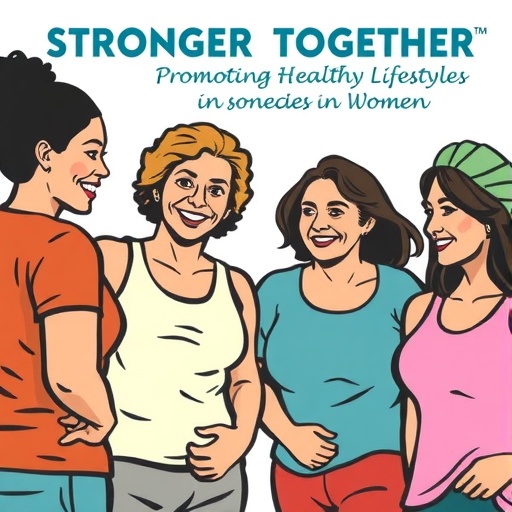In an age where health inequalities persistently cast long shadows over disadvantaged communities, researchers are increasingly turning their focus to innovative, community-driven approaches to bridge these gaps. A groundbreaking feasibility study, recently published in the International Journal for Equity in Health, introduces a pioneering intervention that harnesses the Behavior Change Wheel framework to foster healthier lifestyles among women grappling with low socioeconomic status. This research not only offers a novel perspective on public health strategies but also provides compelling evidence about the transformative power of community-based initiatives.
The study, led by a team including Alageel, Alsukait, and Alharbi, embarks on a meticulous exploration of how behavior change theories applied within communities can disrupt entrenched patterns of unhealthy living. Women of low socioeconomic standing often face multifaceted barriers ranging from limited access to nutritious food and safe exercise opportunities to psychological stressors heightened by economic instability. The intervention developed in this study is designed specifically to address these obstacles through a structured yet adaptable framework.
At the heart of this approach lies the Behavior Change Wheel (BCW), a theoretical model conceptualized to understand and influence the mechanisms underpinning behavior modification. The BCW synthesizes key components such as Capability, Opportunity, and Motivation (COM-B system), creating a comprehensive lens through which behavioral challenges can be analyzed and tackled. By embedding this framework into a community-based setting, the researchers sought to promote enduring lifestyle transformations that resonate culturally and socially with their target demographic.
This feasibility study methodically implemented tailored activities aiming to enhance physical activity, improve dietary habits, and encourage mental well-being among participating women. The intervention was delivered via trusted local networks, leveraging peer support, social incentives, and accessible educational resources. This local embeddedness proved critical in overcoming resistance, fostering engagement, and cultivating a sense of collective empowerment among participants.
A significant technical aspect of this work was its mixed-methods design, integrating quantitative metrics with qualitative feedback to yield a holistic picture of the intervention’s effectiveness and acceptability. Quantitative data included measurable outcomes like changes in physical activity levels, nutritional intake, and biometric markers. Concurrently, qualitative interviews elucidated the personal experiences, perceived barriers, and motivational drivers influencing participant adherence and satisfaction.
Preliminary results indicated promising behavioral shifts, with participating women reporting increased confidence in making health-related decisions and greater involvement in community support systems. Importantly, these changes appeared sustainable beyond the immediate timeframe of the study, suggesting that the BCW framework’s integration into community health programs can produce meaningful long-term benefits.
Moreover, the study addressed the challenge of scalability and adaptability, crucial considerations for public health initiatives targeting diverse urban and rural environments. By demonstrating that the BCW-based intervention could be contextually tailored without compromising integrity, the findings pave the way for broader implementation across various socioeconomic and cultural landscapes.
Crucially, this research underscores the significance of acknowledging social determinants of health in program design, recognizing that health behaviors are frequently a function of broader structural factors. By situating the intervention within women’s lived realities, accounting for access issues, social support networks, and cultural norms, the study advances a more nuanced and equitable public health paradigm.
On a psychological level, the emphasis on motivation within the BCW coincides with theories of self-efficacy and intrinsic motivation, both pivotal for sustaining behavioral change. The intervention’s strategic use of motivational interviewing, peer role models, and goal-setting exercises exemplifies best practices in enhancing personal agency.
Another methodological innovation involved continuous participant feedback loops, which allowed for dynamic adjustment of the intervention components. This iterative process not only heightened relevance and responsiveness but also fostered a collaborative researcher-community partnership, enhancing trust and validity of the outcomes.
Potential implications of this study stretch beyond individual health improvements; by empowering women within marginalized communities, the intervention may catalyze broader social transformations. Healthier, more confident women often act as catalysts within families and neighborhoods, amplifying positive health behaviors and fostering resilient social ties.
Despite its promising outlook, the authors prudently caution on the need for more extensive trials to validate efficacy and explore cost-effectiveness at scale. They advocate for interdisciplinary collaboration, integrating public health, behavioral science, and social policy to holistically address health inequality.
In summary, this feasibility study illuminates a potent pathway forward in the ongoing quest to reduce health disparities via community-based, behaviorally-informed interventions. Through its rigorous application of the Behavior Change Wheel and thoughtful community engagement, it offers both a blueprint and inspiration for future efforts aimed at building healthier, more equitable societies.
This research not only spotlights the critical intersection of behavior change science and social equity but also challenges prevailing notions that individual health behaviors can improve in isolation from environmental and socioeconomic contexts. By weaving together science, compassion, and community empowerment, it sets a new standard for collaborative public health innovation.
For readers and practitioners alike, the study serves as a vivid reminder that healthier lifestyles are not just individual choices but collective achievements contingent on understanding and addressing the complex tapestry of influences impacting behavior. The “Stronger Together” ethos resonates deeply, encapsulating the essence of effective, equitable health promotion in the 21st century.
Subject of Research: Community-based intervention promoting healthier lifestyles among women with low socioeconomic status using the Behavior Change Wheel framework.
Article Title: Stronger Together: a community-based intervention using Behaviour Change Wheel to promote healthier lifestyles among women with low socioeconomic status: a feasibility study.
Article References:
Alageel, S., Alsukait, R., Alharbi, A. et al. Stronger Together: a community-based intervention using Behaviour Change Wheel to promote healthier lifestyles among women with low socioeconomic status: a feasibility study. Int J Equity Health 24, 294 (2025). https://doi.org/10.1186/s12939-025-02654-5
Image Credits: AI Generated




